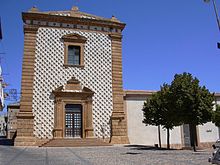Home - In and around
with diamond facade facade and multifunctional center.
The construction of the monumental complex was begun in 1419 for the will of the Blessed Vincenzo da Pistoia, designed by the architect Victorian Vincenzo Di Luca. The temple was dedicated to St. Vincenzo Ferreri, as evidenced by the inscription on the fašade, which reads: "In this temple or high God I have been angry with kindness to welcome the vows of my prayers and here always fund a copious blessing for the Worthy of St. Vincent to whom he was dedicated. " In this church the relic of the Lord's spine was worshiped.
The temple is remarkable for the diamond-shaped white facade, which is very rare in religious buildings, but mostly found in political buildings such as the Seri Pinto of Sciacca, and the Diamond Palace in Ferrara. On the sides of the fašade there are two tall and slender cantonals in sandstone (coming from the mountain contrada), where the Plateresque style differs from Catalonia in the second half of the fifteenth century.
The cantons culminate in a lower tympanum, marked by metaphys and trilobs. Very beautiful and accurate and the portal, on whose sides there are two slopes where the plateres style is again. Leaves culminate with a corinthian capital embellished by angel's faces. The church is a single nave, completed by an apse. Architects when they restored the church after the earthquake of 1693 left the right wall in stone and the other with 18th-century stuccoes. In the apse there are few traces of a fifteenth-century rosette. On the sides of the apse are two cantons (always sandstone) ending with a Corinthian capital.
The monastery, built near the church, lived for four centuries an intense religious life, until the death of the Dominicans by Aidone. She was later used as a male elementary school until she was abandoned and collapsed.
Source wikipedia
CHURCH AND FORMER MONASTERY OF SAN DOMENICO
with diamond facade facade and multifunctional center.
The construction of the monumental complex was begun in 1419 for the will of the Blessed Vincenzo da Pistoia, designed by the architect Victorian Vincenzo Di Luca. The temple was dedicated to St. Vincenzo Ferreri, as evidenced by the inscription on the fašade, which reads: "In this temple or high God I have been angry with kindness to welcome the vows of my prayers and here always fund a copious blessing for the Worthy of St. Vincent to whom he was dedicated. " In this church the relic of the Lord's spine was worshiped.
The temple is remarkable for the diamond-shaped white facade, which is very rare in religious buildings, but mostly found in political buildings such as the Seri Pinto of Sciacca, and the Diamond Palace in Ferrara. On the sides of the fašade there are two tall and slender cantonals in sandstone (coming from the mountain contrada), where the Plateresque style differs from Catalonia in the second half of the fifteenth century.
The cantons culminate in a lower tympanum, marked by metaphys and trilobs. Very beautiful and accurate and the portal, on whose sides there are two slopes where the plateres style is again. Leaves culminate with a corinthian capital embellished by angel's faces. The church is a single nave, completed by an apse. Architects when they restored the church after the earthquake of 1693 left the right wall in stone and the other with 18th-century stuccoes. In the apse there are few traces of a fifteenth-century rosette. On the sides of the apse are two cantons (always sandstone) ending with a Corinthian capital.
The monastery, built near the church, lived for four centuries an intense religious life, until the death of the Dominicans by Aidone. She was later used as a male elementary school until she was abandoned and collapsed.
Source wikipedia



